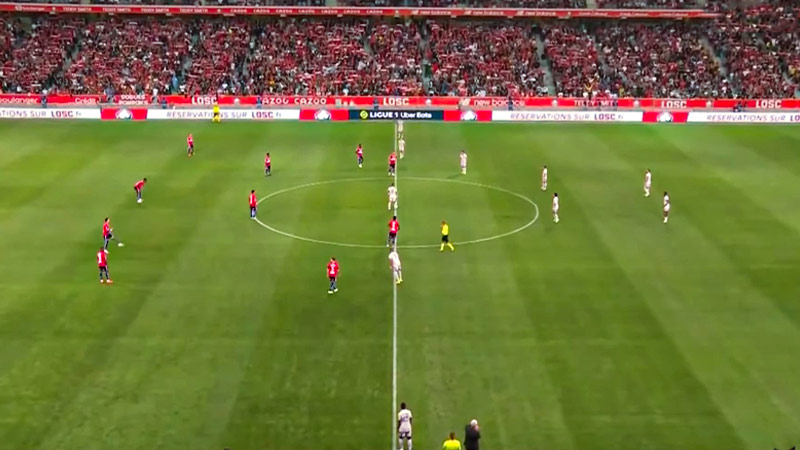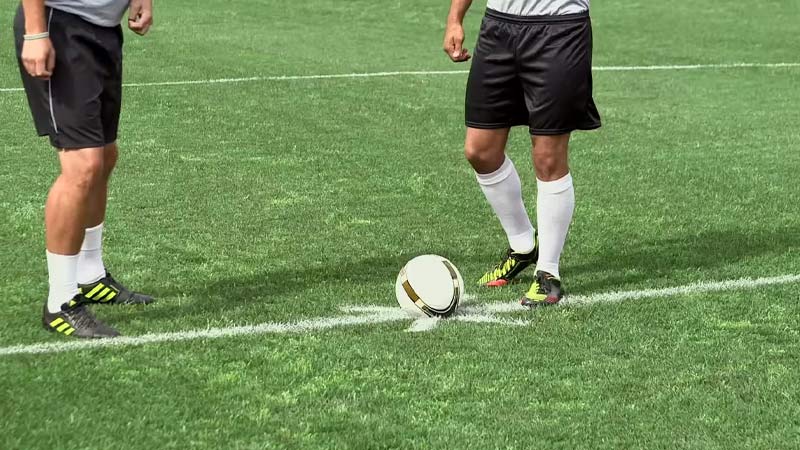The kickoff triggers the key of Soccer. Even though it may look like a simple move to start or resume a match, it can help your team dominate the field from the beginning.
Similarly, during a La Liga match between Real Madrid and Osasuna in 2010, Xabi Alonso pulled off an ingenious backheel assist from the kickoff.
We can have more on kickoffs, such as what kickoff is, what soccer kickoff rules are, and most importantly, how important kickoffs are.
Stay with us and let’s raise a cup of coffee over soccer kickoffs today!
What Is Soccer Kickoff?
The kickoff is the starting point of a soccer match. It takes place at the center circle of the field during the (1) beginning of the match, (2) after a goal is scored, and (3) at the start of the second half.
– According to International Football Association Board (IFAB) guidelines.
A lot of people may know or not know this but, you can restart a soccer match other than kickoffs too.
It is not unusual to resume soccer with throw-ins, goal kicks, direct/ indirect free kicks, penalty kicks, corner kicks, or a drop ball.
The referee decides which one to go with based on the requirements and conditions of a match.
Here is how it goes,
The referee flips a coin. Each team selects one side of the coin. The winning team then gets to decide, whether they will take the kickoff or attempt to goal.
When your team selects to goal in the first half, you have to switch the roles in the second half. Generally, the toss-winning team takes the kickoff and it happens for the most.
However, this decision can often be influenced by other factors such as poor weather conditions or pre-built strategies.
For example, in foggy weather, you need to decide tactically. As defense becomes challenging during this time, you may not want to go for a goal.
Or, in other cases where the wind direction is in your favor, it would be wise to avail the scoring opportunities and select to goal.
Soccer Kickoff Rules Defined

Most of us think kickoffs are simple moves! In smaller league and college football, teams may not be so strict about following kickoff rules.
But look at the FIFA World Cup or other cup tournaments, we have strict soccer kickoff rules that are widely applied and followed. Here are the rules listed below,
- The Lineup: All players remain in their half of the field except for the players who only perform the kickoff.
- The Opponent: The team not performing the kickoff must be in their own half of the field, while the team taking the kickoff must be in the center circle.
The opponents must be at least 10 yards (9.15 meters) away from the ball until the kickoff and the ball is in play.
- Role of Referee: The referee places the ball at the center of the circle. And he blows the whistle to signal the beginning of the kickoff.
As soon as the ball gets into play, all players can move along and get into formation.
- The Ball Moves Forward: The player who takes the kickoff can kick in any direction.
Earlier, the ball moved forward before a teammate could touch it, but this rule had to change. It often offered the kicker’s team to immediately regain possession from the kickoff.
- Role of Referee: The referee places the ball at the center of the circle. And he blows the whistle to signal the beginning of the kickoff.
- Scoring Opportunities: If possible, a team can score directly from a kickoff. A goal is awarded when a player directly kicks the ball into the opponent’s goal without touching any other player.
- Indirect Free Kick: Not often but not rare! The ball may not move forward from the kickoff or a player touches the ball before it moves.
Normally, the player who takes the kickoff can’t touch the ball until there is a contact by another player. Hence, he can transfer the ball to a teammate but not dribble it.
When this happens, the opposing team gets an indirect free kick from the spot of violation.
Other offenses can result in a retake. Also, even if a player delays the kick-off intentionally, the referee may show him a yellow card.
Mark that, the offside rule is not applicable from a kickoff. A player must not remain at the offside from a goal kick, corner kick, or throw-in as well.
How Does the Second Half of Soccer Start?
A bit of talk about this we had earlier in our article. In the second half of Soccer, the team that did not take the kick-off at the start of the first half takes the kickoff this time.
Both teams will again meet a kickoff after a goal is scored. The game will restart with a kickoff by the team who scored the goal this time. It starts the same way from the center mark in the middle of the field.
The Secrets of Kickoff Strategies
The kickoff might seem like a straightforward action. But the move also holds strategic significance in soccer matches.
The team that takes the kickoff can set the tone of the match with an attack or by playing a controlled possession from the beginning.
Let’s not forget how Carlos Tevez stunned everyone by scoring from the center circle just seconds after the kickoff. It happened in 2010, during the premier league match between Manchester City and Stoke City.
Also, the kickoff was a promising opportunity for our young Leonel Messi. In a La Liga match between Barcelona and Getafe in 2007, he showcased his exceptional dribbling skills from the kickoff.
Closing Up
Here we are at the end of our article. The kickoff can also improve sportsmanship. Not just a means to restart a paused game, but apply it correctly and you have higher chances to lead the match.
The Soccer Kickoff Rules keep all in one place and organized. Players can’t go above the law and expect fairness. That’s why, kickoff rules came to act.
What do you think? Tell us a bit about what you think of the kickoff rules. Leave a comment below.
Also, don’t forget to share our article with your friends and crazy soccer lovers.







